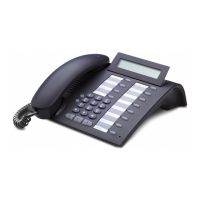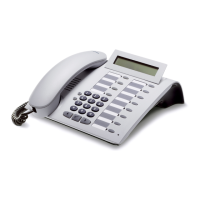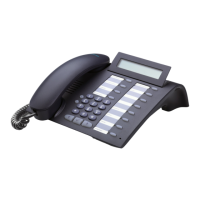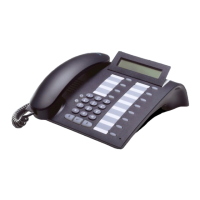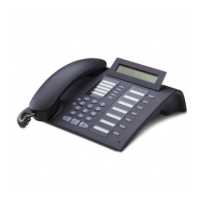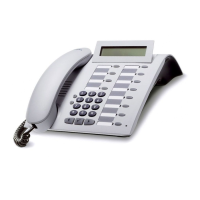



Do you have a question about the Siemens optiPoint 420 economy plus and is the answer not in the manual?
| Speakerphone | Yes |
|---|---|
| Headset port | Yes |
| Wall mountable | Yes |
| Message Waiting Indicator | Yes |
| Lines | 1 |
| Memory Locations | 10 |
| Type | Digital phone |
| Display | 2-line LCD display |
| Keypad | 12-key |
| Programmable keys | 8 |
| Power Supply | Via telephone line |
| Dimensions | 200 x 200 x 90 mm |
Lists critical safety and operational notes for the telephone.
Identifies keys, display, and components of the optiPoint 420 control panel.
Guide on interpreting symbols and understanding the manual's structure.
Methods to activate and use telephone functions interactively or via menus.
Categorization of available telephone functions: SLK, basic, enhanced, and team functions.
Advice on saving numbers and using callback for efficient telephone operation.
Procedures for answering calls via handset or speakerphone mode.
Instructions for initiating calls using off-hook and on-hook dialing methods.
Methods for redialing recently dialed numbers and accessing saved numbers.
Procedure for placing a call on hold to consult with a second party.
Steps involved in transferring an ongoing call to another colleague.
Instructions for setting up and deactivating variable call forwarding.
How to answer a ringing call intended for a colleague.
Process for declining incoming calls and signaling them elsewhere.
How to conduct calls using the speakerphone mode.
Using the telephone to communicate with visitors at the entrance and open doors.
Procedures for en-bloc dialing, correcting numbers, and canceling en-bloc sending.
Accessing and managing the list of incoming calls.
Storing and using station and system speed-dial numbers for quick dialing.
Managing calls while already engaged, including call waiting and camp-on.
Placing active calls on hold to be retrieved later from any telephone.
Initiating and managing multi-party conference calls.
Forwarding external calls to a specific internal telephone during non-working hours.
Programming specific functions or procedures onto programmable telephone keys.
Setting up timed reminders for appointments via telephone calls.
Viewing call charges for the current or last conducted calls.
Assigning external calls to specific projects using account codes.
Activating or deactivating the ringer to avoid receiving calls.
Enabling or disabling the Do Not Disturb function to block incoming calls.
Preventing your station number or name from appearing on external caller displays.
Preventing unauthorized access to the telephone and its electronic notebook.
Setting and saving a personal identification number (PIN) for security.
Sending short text messages (infotexts) to single users or groups.
Temporarily using another telephone as if it were your own for outgoing calls.
Using a remote telephone with your station number and settings for an extended period.
Activating or deactivating audible signals for hunt groups, group calls, or trunks.
Answering calls intended for other team members, even when on another call.
Setting up audible signals for your telephone on up to five other internal phones.
Managing agent availability and call distribution within a UCD group.
Understanding the function of trunk keys and their LED indications for call management.
How to answer incoming calls using trunk keys on your telephone.
Using free trunk keys to initiate outgoing calls.
Setting up call forwarding for specific lines or trunks.
Understanding DSS key functions and LED indications for team communication.
Reaching team members quickly by pressing their direct station selection (DSS) key.
Transferring an active call to another person using DSS keys.
Performing a self-test to verify all telephone functions are operational.
Verifying which functions are programmed onto specific telephone keys.
Modifying or resetting the text label for an already programmed telephone key.
How to input alphanumeric characters using the telephone keypad by pressing keys multiple times.
How key function labels are displayed and can be customized.
Information on obtaining operating instructions in PDF or HTML formats.
Guidelines for cleaning and maintaining the telephone to ensure proper operation.
Common issues like unresponsive keys or no ringing, and their solutions.


